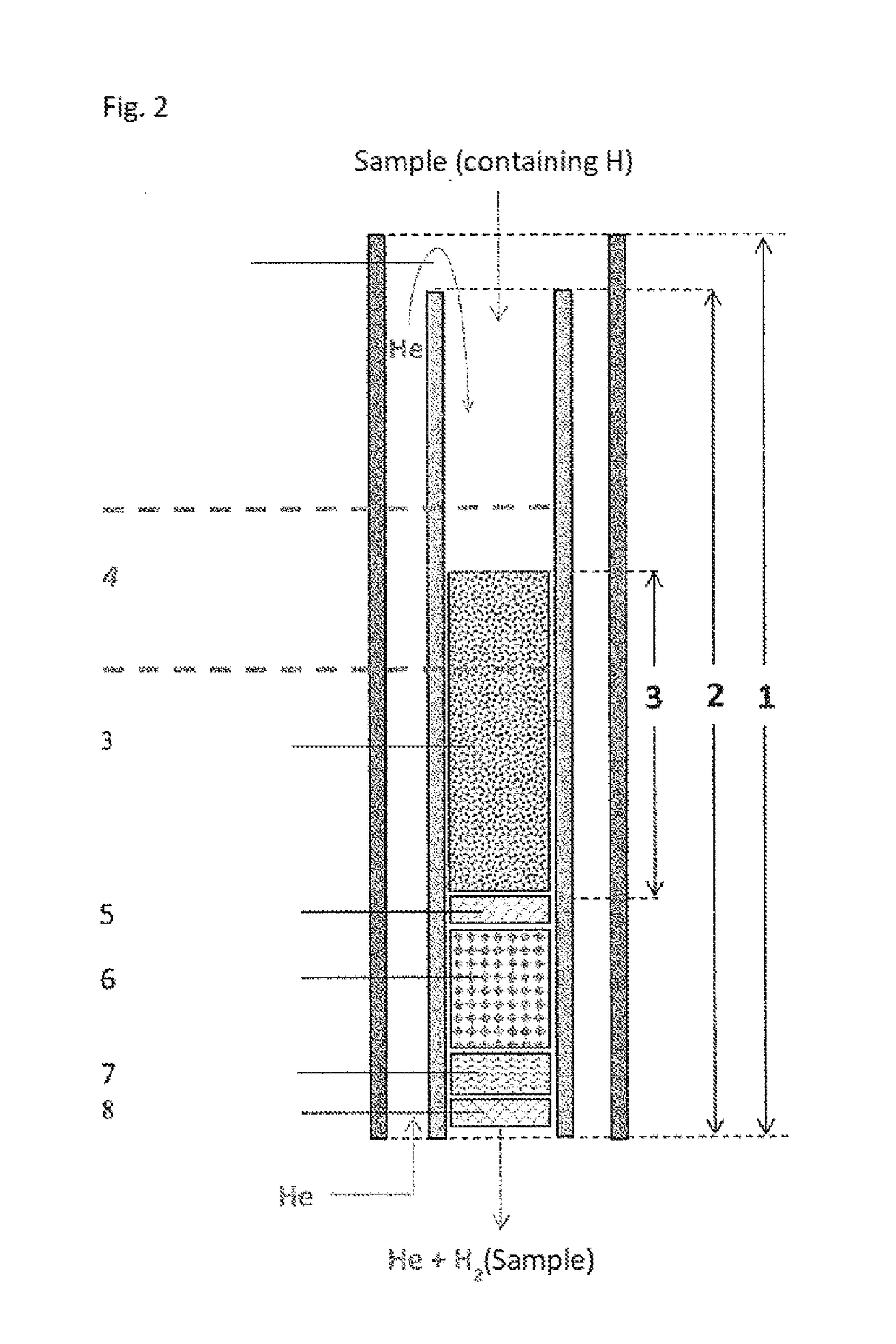Use of a reactor, methods, and device for quantitatively obtaining molecular hydrogen from substances
a molecular hydrogen and molecular hydrogen technology, applied in the direction of separation processes, physical/chemical process catalysts, instruments, etc., to achieve the effect of increasing the yield of molecular hydrogen
- Summary
- Abstract
- Description
- Claims
- Application Information
AI Technical Summary
Benefits of technology
Problems solved by technology
Method used
Image
Examples
example 1
[0163]Use example, based on caffeine, using a double-walled pyrolysis reactor according to FIG. 2:
[0164]Solid samples are weighed in silver capsules. The silver capsules are placed in the autosampler of the analyzer (EA). From there, the samples drop individually into the pyrolysis reactor, wherein the silver capsule melts in the hot zone and the sample decomposes. The fluid reaction products are transported with the carrier gas helium through a gas chromatography column to the open split module. From there, the carrier gas stream including the H2 enters the isotope ratio mass spectrometer, wherein the ion streams of the masses are determined and compared to those of a calibrated reference gas.
[0165]The reaction is carried out by means of a standard high-temperature conversion system for elemental analysis (HTC System; e.g. TC / EA from Thermo Fisher Scientific GmbH, Bremen, Germany, without chromium) and a high-temperature conversion system for elemental analysis (Cr-EA system) accor...
example 2
[0168]Use example, based on caffeine, using a pyrolysis reactor according to FIG. 3
[0169]The fluid reaction products are transported with the carrier gas helium through a gas chromatography column to the open split module. From there, the carrier gas stream including the H2 enters the isotope ratio mass spectrometer, wherein the ion streams of the masses are determined and compared to those of a calibrated reference gas.
[0170]The reaction is carried out by means of a standard high-temperature conversion system (GC / HTC System; e.g. standard TC / GC system, e.g. from Thermo Fisher Scientific GmbH, Bremen, Germany, without chromium) and a high-temperature conversion system (GC-Cr system) according to the invention. In this case, the caffeine has been divided into its components by means of gas chromatography prior to entry in the pyrolysis reactor.
[0171]As can be seen in the attached FIGS. 8 and 9, the known GC / HTC system leads to the formation of byproducts which limit the yield of mole...
example 3
[0180]Use example, based on hexachlorocyclohexane, using a pyrolysis reactor according to FIG. 3:
[0181]The fluid reaction products are transported with the carrier gas helium through a gas chromatography column to the open split module. From there, the carrier gas stream including the H2 enters the isotope ratio mass spectrometer, wherein the ion streams of the masses are determined and compared to those of a calibrated reference gas.
[0182]The reaction is carried out by means of a standard high-temperature conversion system (GC / HTC System; e.g. standard TC / GC system, e.g. from Thermo Fisher Scientific GmbH, Bremen, Germany, without chromium) and a high-temperature conversion system (GC-Cr system) according to the invention. In this case, the hexachlorocyclohexane has been divided into its components by means of gas chromatography prior to entry in the pyrolysis reactor.
[0183]FIGS. 12 and 13: Formation of byproducts containing hydrogen (HCl) during the conversion of the hydrogen in t...
PUM
| Property | Measurement | Unit |
|---|---|---|
| temperatures | aaaaa | aaaaa |
| temperature | aaaaa | aaaaa |
| temperature | aaaaa | aaaaa |
Abstract
Description
Claims
Application Information
 Login to View More
Login to View More - R&D
- Intellectual Property
- Life Sciences
- Materials
- Tech Scout
- Unparalleled Data Quality
- Higher Quality Content
- 60% Fewer Hallucinations
Browse by: Latest US Patents, China's latest patents, Technical Efficacy Thesaurus, Application Domain, Technology Topic, Popular Technical Reports.
© 2025 PatSnap. All rights reserved.Legal|Privacy policy|Modern Slavery Act Transparency Statement|Sitemap|About US| Contact US: help@patsnap.com



